15 лицей Солженицын.pptx
- Количество слайдов: 30
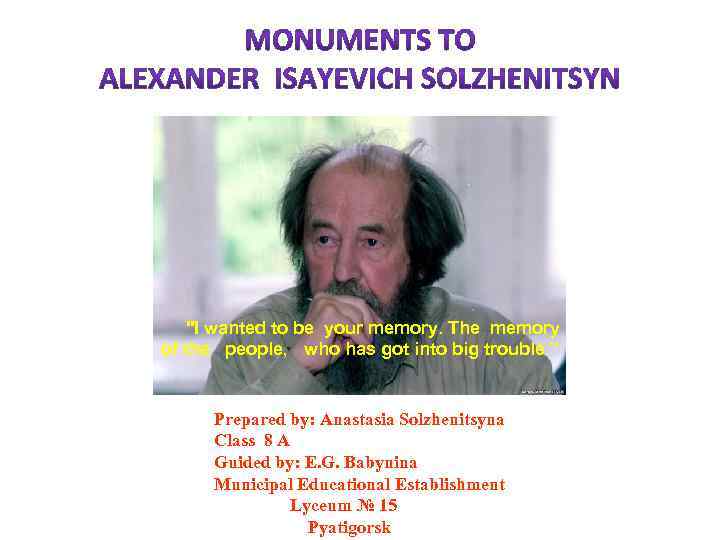
"I wanted to be your memory. The memory of the people, who has got into big trouble. ” Prepared by: Anastasia Solzhenitsyna Class 8 A Guided by: E. G. Babynina Municipal Educational Establishment Lyceum № 15 Pyatigorsk
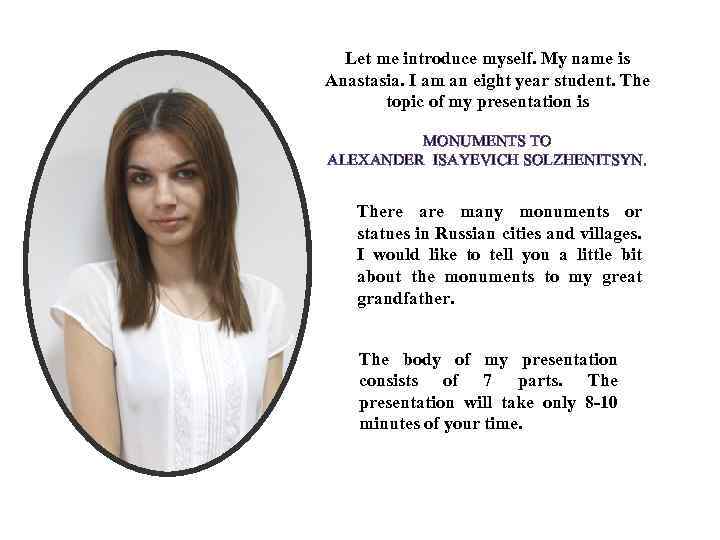
Let me introduce myself. My name is Anastasia. I am an eight year student. The topic of my presentation is MONUMENTS TO ALEXANDER ISAYEVICH SOLZHENITSYN. There are many monuments or statues in Russian cities and villages. I would like to tell you a little bit about the monuments to my great grandfather. The body of my presentation consists of 7 parts. The presentation will take only 8 -10 minutes of your time.
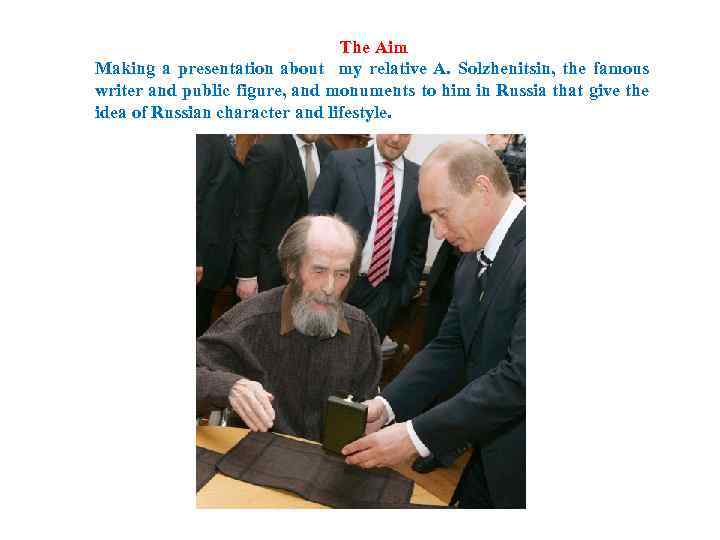
The Aim Making a presentation about my relative A. Solzhenitsin, the famous writer and public figure, and monuments to him in Russia that give the idea of Russian character and lifestyle.
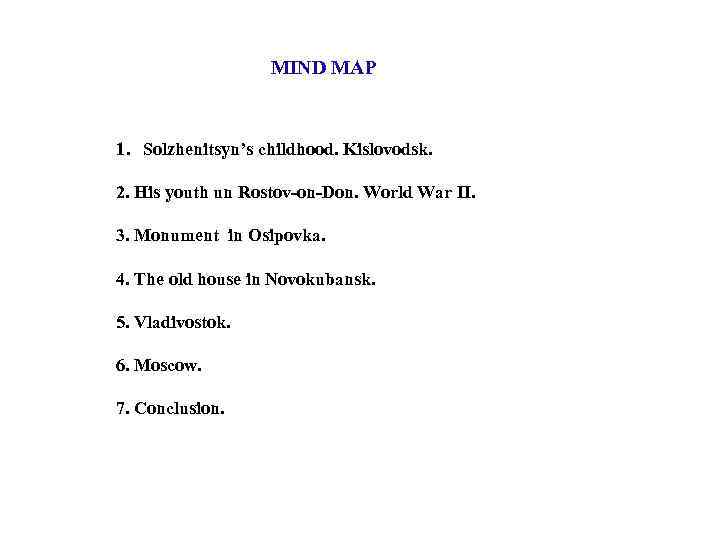
MIND MAP 1. Solzhenitsyn’s childhood. Kislovodsk. 2. His youth un Rostov-on-Don. World War II. 3. Monument in Osipovka. 4. The old house in Novokubansk. 5. Vladivostok. 6. Moscow. 7. Conclusion.
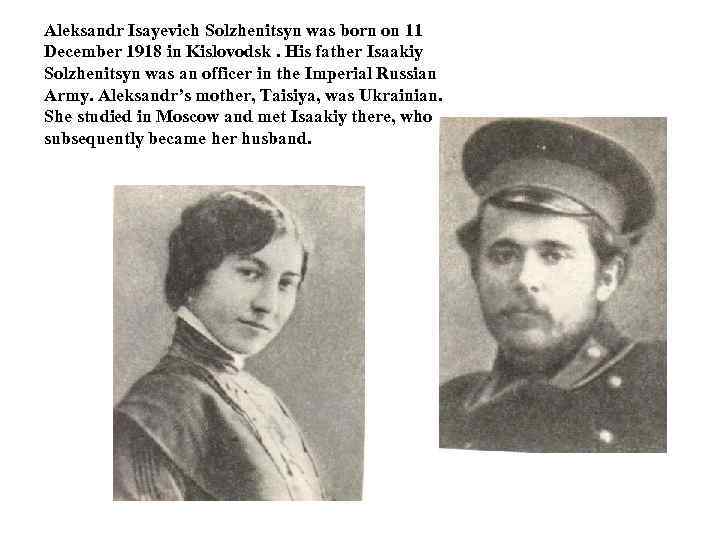
Aleksandr Isayevich Solzhenitsyn was born on 11 December 1918 in Kislovodsk. His father Isaakiy Solzhenitsyn was an officer in the Imperial Russian Army. Aleksandr’s mother, Taisiya, was Ukrainian. She studied in Moscow and met Isaakiy there, who subsequently became her husband.
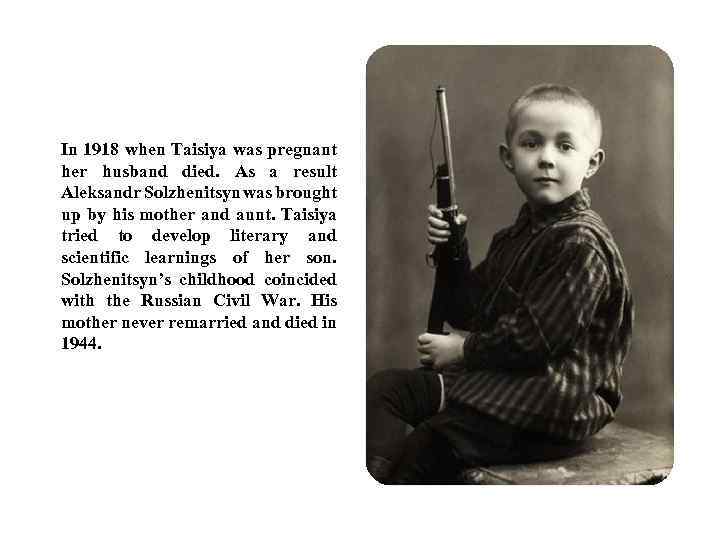
In 1918 when Taisiya was pregnant her husband died. As a result Aleksandr Solzhenitsyn was brought up by his mother and aunt. Taisiya tried to develop literary and scientific learnings of her son. Solzhenitsyn’s childhood coincided with the Russian Civil War. His mother never remarried and died in 1944.
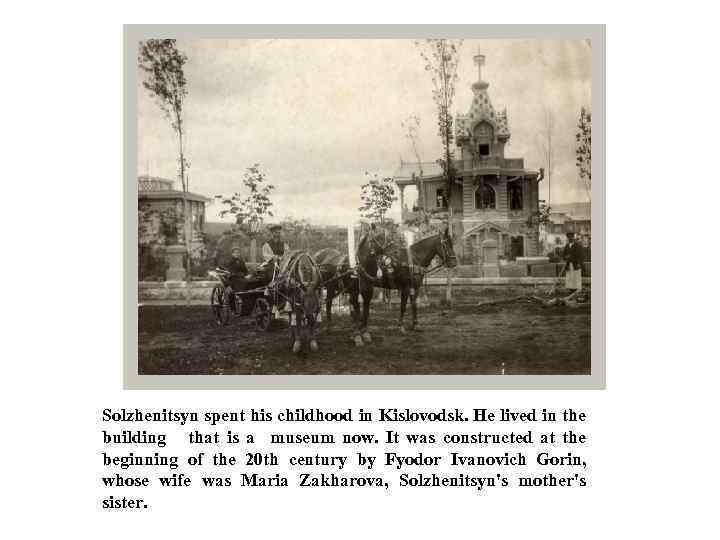
Solzhenitsyn spent his childhood in Kislovodsk. He lived in the building that is a museum now. It was constructed at the beginning of the 20 th century by Fyodor Ivanovich Gorin, whose wife was Maria Zakharova, Solzhenitsyn's mother's sister.
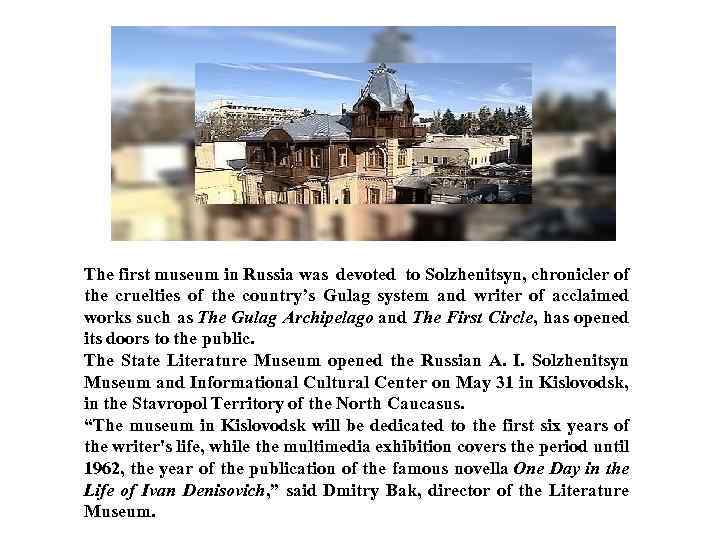
The first museum in Russia was devoted to Solzhenitsyn, chronicler of the cruelties of the country’s Gulag system and writer of acclaimed works such as The Gulag Archipelago and The First Circle, has opened its doors to the public. The State Literature Museum opened the Russian A. I. Solzhenitsyn Museum and Informational Cultural Center on May 31 in Kislovodsk, in the Stavropol Territory of the North Caucasus. “The museum in Kislovodsk will be dedicated to the first six years of the writer's life, while the multimedia exhibition covers the period until 1962, the year of the publication of the famous novella One Day in the Life of Ivan Denisovich, ” said Dmitry Bak, director of the Literature Museum.
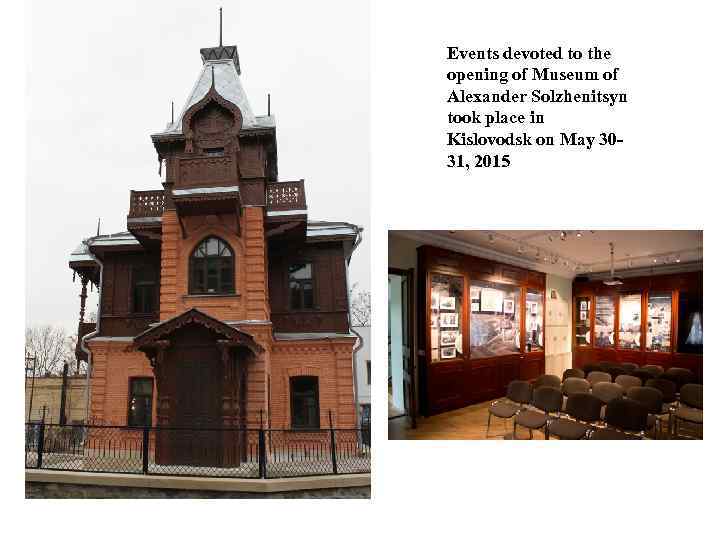
Events devoted to the opening of Museum of Alexander Solzhenitsyn took place in Kislovodsk on May 3031, 2015
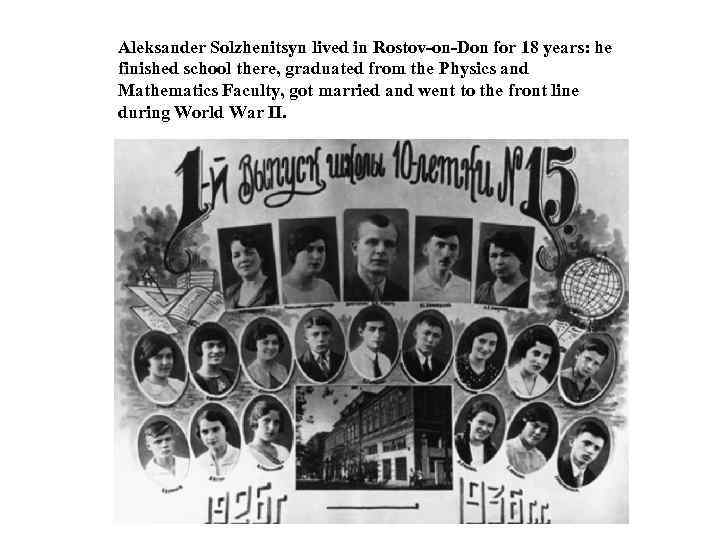
Aleksander Solzhenitsyn lived in Rostov-on-Don for 18 years: he finished school there, graduated from the Physics and Mathematics Faculty, got married and went to the front line during World War II.
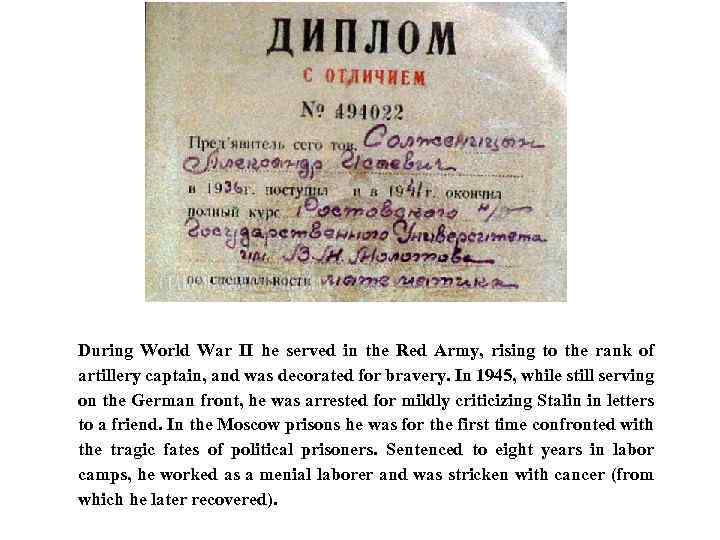
During World War II he served in the Red Army, rising to the rank of artillery captain, and was decorated for bravery. In 1945, while still serving on the German front, he was arrested for mildly criticizing Stalin in letters to a friend. In the Moscow prisons he was for the first time confronted with the tragic fates of political prisoners. Sentenced to eight years in labor camps, he worked as a menial laborer and was stricken with cancer (from which he later recovered).

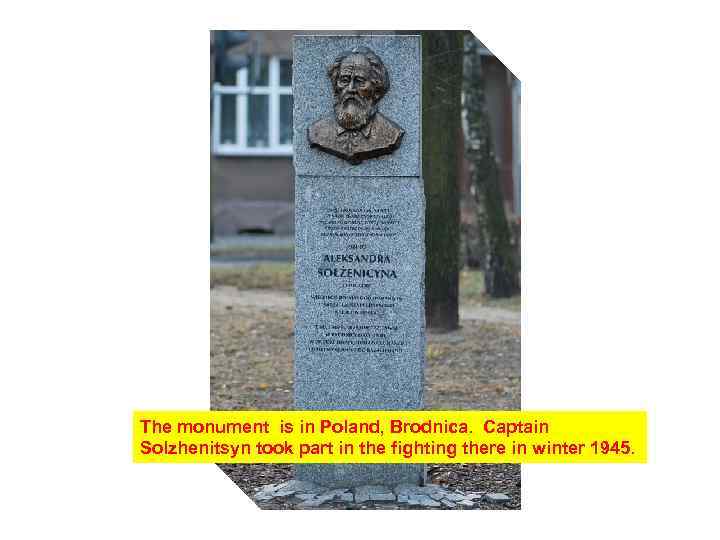
The monument is in Poland, Brodnica. Captain Solzhenitsyn took part in the fighting there in winter 1945.
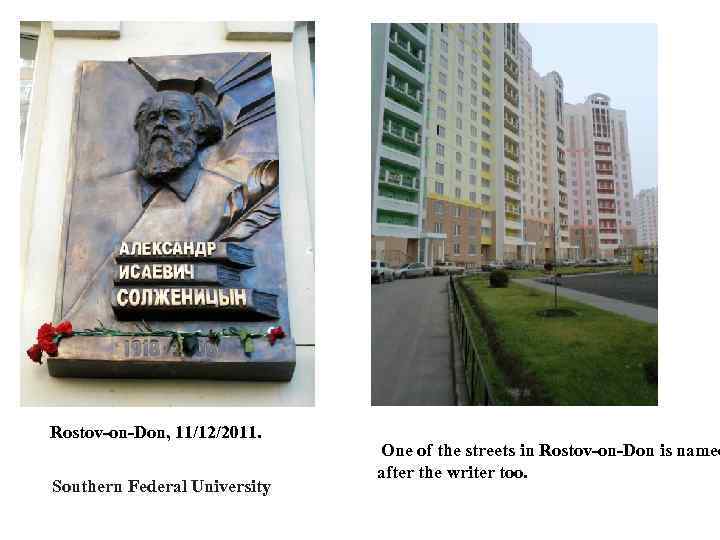
Rostov-on-Don, 11/12/2011. Southern Federal University One of the streets in Rostov-on-Don is named after the writer too.
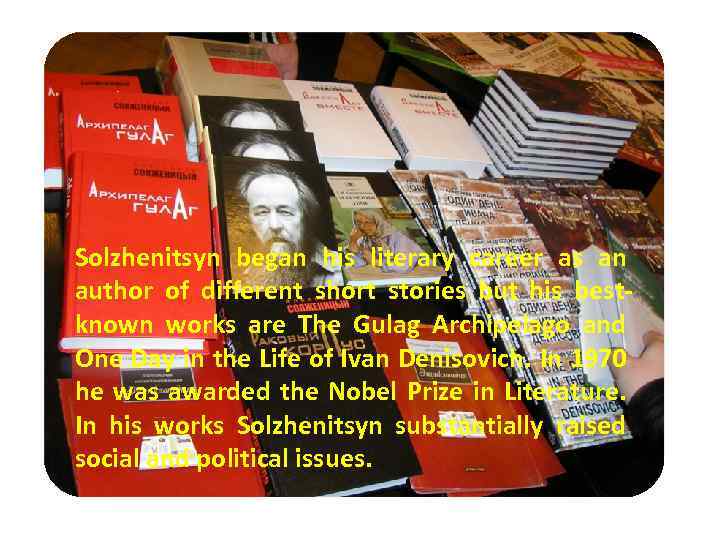
Solzhenitsyn began his literary career as an author of different short stories but his bestknown works are The Gulag Archipelago and One Day in the Life of Ivan Denisovich. In 1970 he was awarded the Nobel Prize in Literature. In his works Solzhenitsyn substantially raised social and political issues.
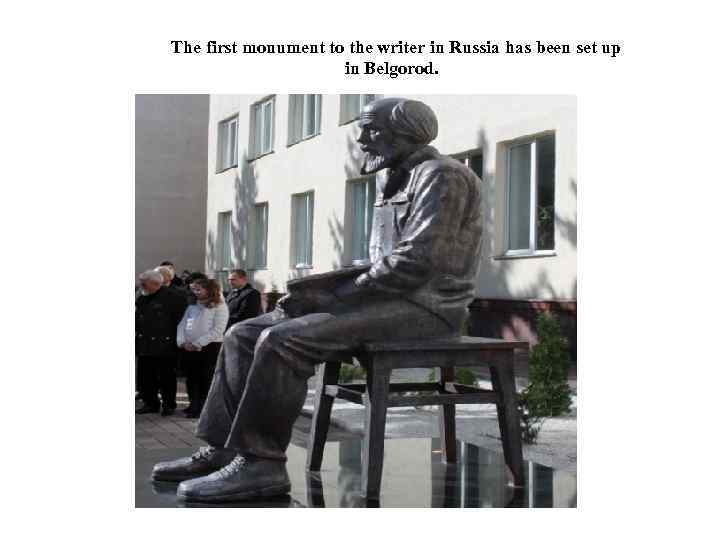
The first monument to the writer in Russia has been set up in Belgorod.
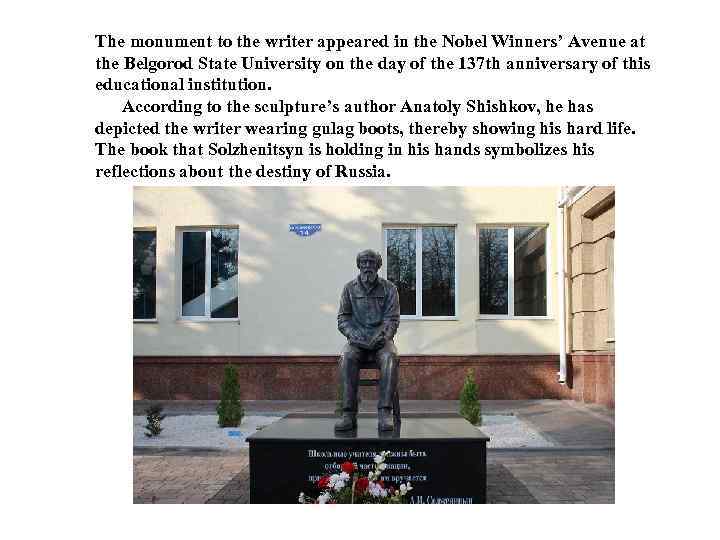
The monument to the writer appeared in the Nobel Winners’ Avenue at the Belgorod State University on the day of the 137 th anniversary of this educational institution. According to the sculpture’s author Anatoly Shishkov, he has depicted the writer wearing gulag boots, thereby showing his hard life. The book that Solzhenitsyn is holding in his hands symbolizes his reflections about the destiny of Russia.
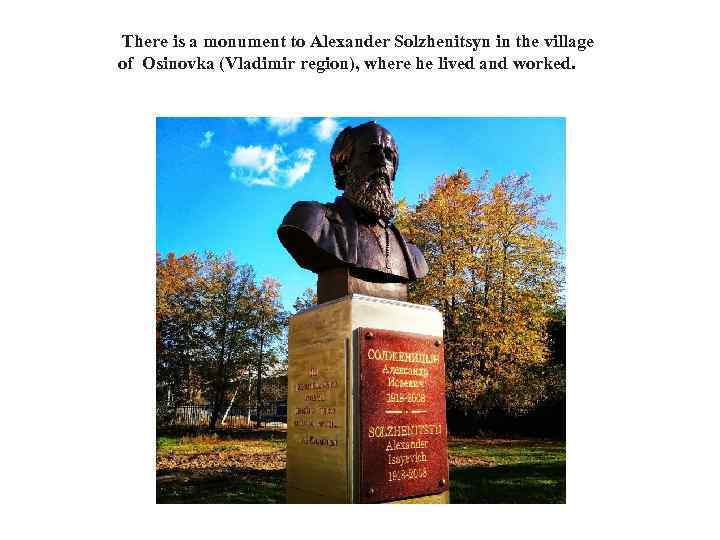
There is a monument to Alexander Solzhenitsyn in the village of Osinovka (Vladimir region), where he lived and worked.
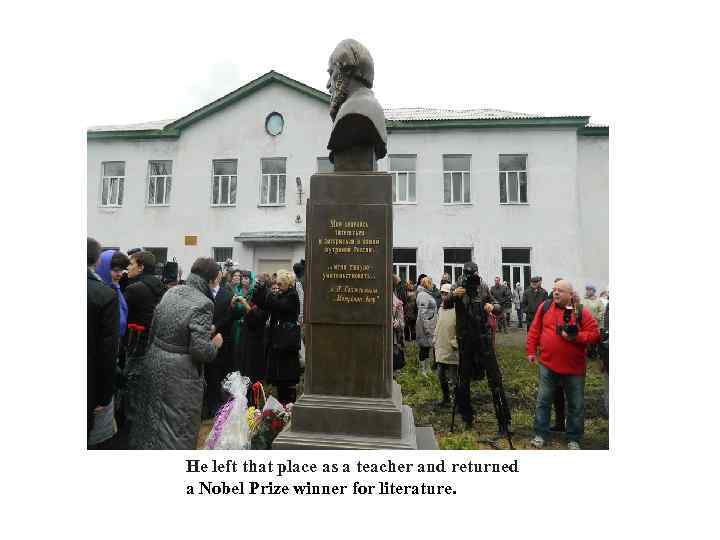
He left that place as a teacher and returned a Nobel Prize winner for literature.

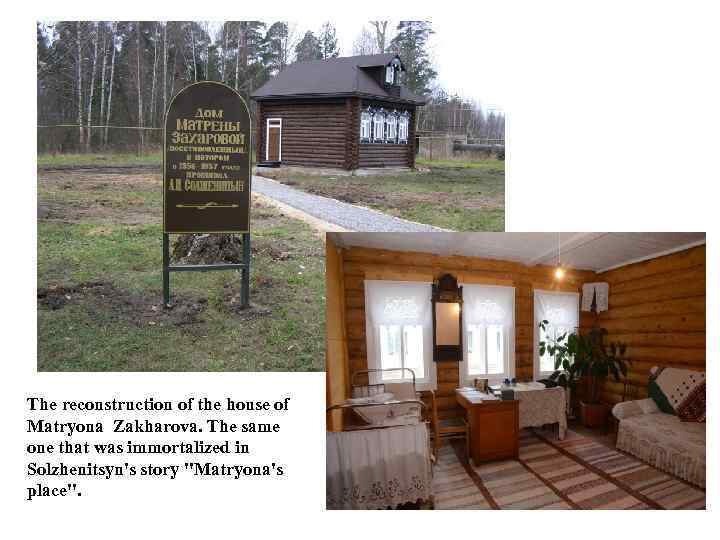
The reconstruction of the house of Matryona Zakharova. The same one that was immortalized in Solzhenitsyn's story "Matryona's place".
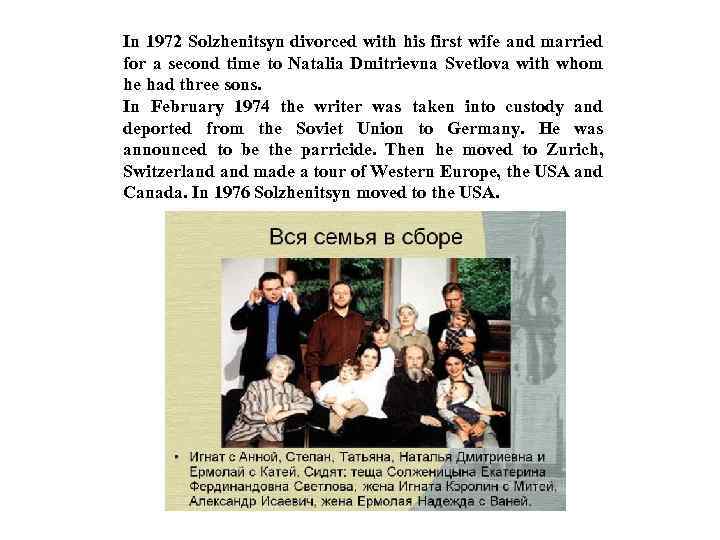
In 1972 Solzhenitsyn divorced with his first wife and married for a second time to Natalia Dmitrievna Svetlova with whom he had three sons. In February 1974 the writer was taken into custody and deported from the Soviet Union to Germany. He was announced to be the parricide. Then he moved to Zurich, Switzerland made a tour of Western Europe, the USA and Canada. In 1976 Solzhenitsyn moved to the USA.
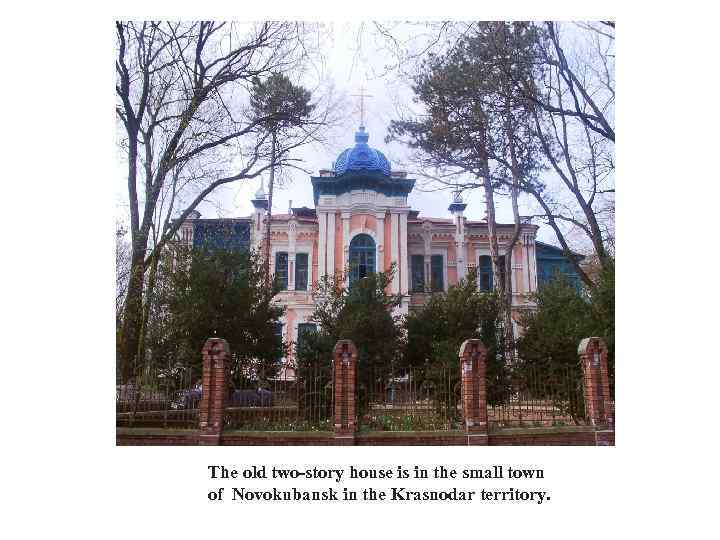
The old two-story house is in the small town of Novokubansk in the Krasnodar territory.
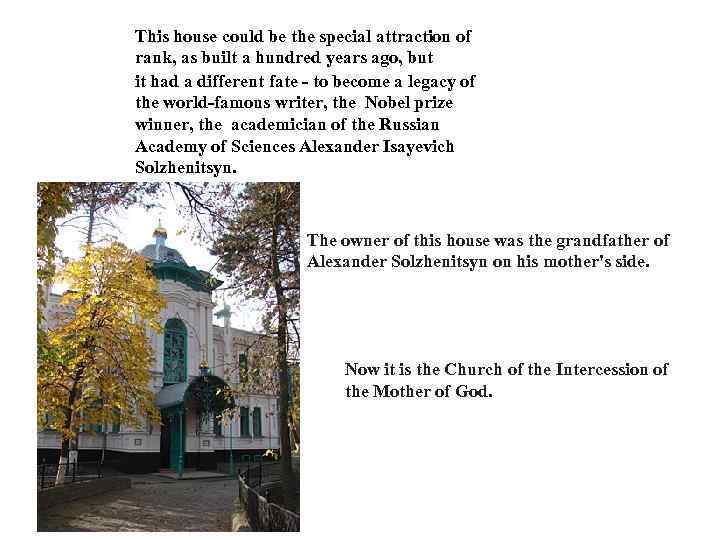
This house could be the special attraction of rank, as built a hundred years ago, but it had a different fate - to become a legacy of the world-famous writer, the Nobel prize winner, the academician of the Russian Academy of Sciences Alexander Isayevich Solzhenitsyn. The owner of this house was the grandfather of Alexander Solzhenitsyn on his mother's side. Now it is the Church of the Intercession of the Mother of God.
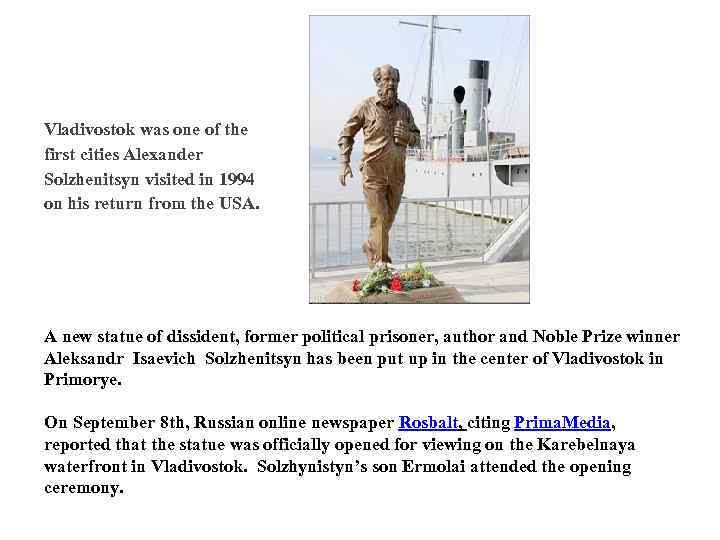
Vladivostok was one of the first cities Alexander Solzhenitsyn visited in 1994 on his return from the USA. A new statue of dissident, former political prisoner, author and Noble Prize winner Aleksandr Isaevich Solzhenitsyn has been put up in the center of Vladivostok in Primorye. On September 8 th, Russian online newspaper Rosbalt, citing Prima. Media, reported that the statue was officially opened for viewing on the Karebelnaya waterfront in Vladivostok. Solzhynistyn’s son Ermolai attended the opening ceremony.
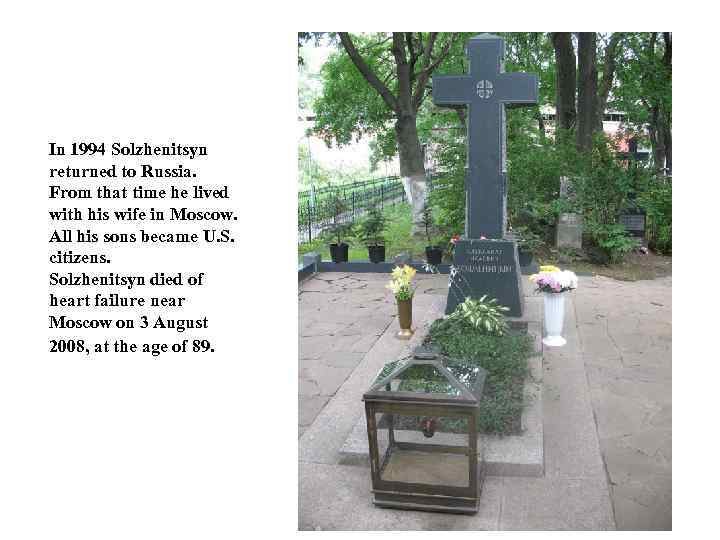
In 1994 Solzhenitsyn returned to Russia. From that time he lived with his wife in Moscow. All his sons became U. S. citizens. Solzhenitsyn died of heart failure near Moscow on 3 August 2008, at the age of 89.
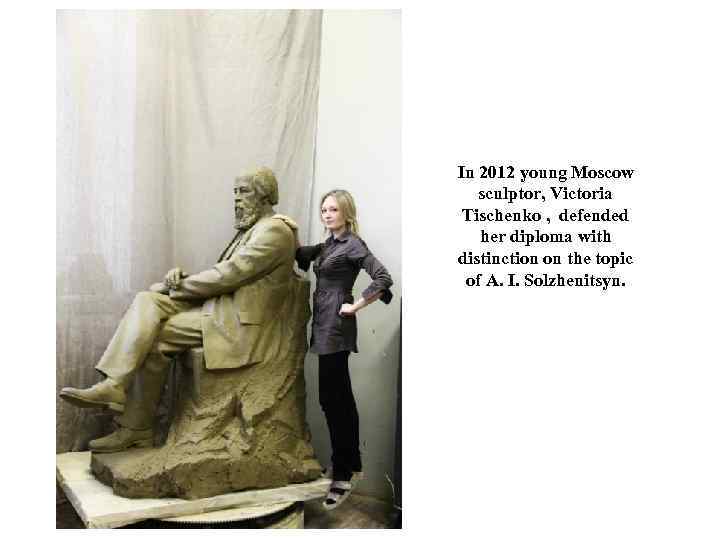
In 2012 young Moscow sculptor, Victoria Tischenko , defended her diploma with distinction on the topic of A. I. Solzhenitsyn.
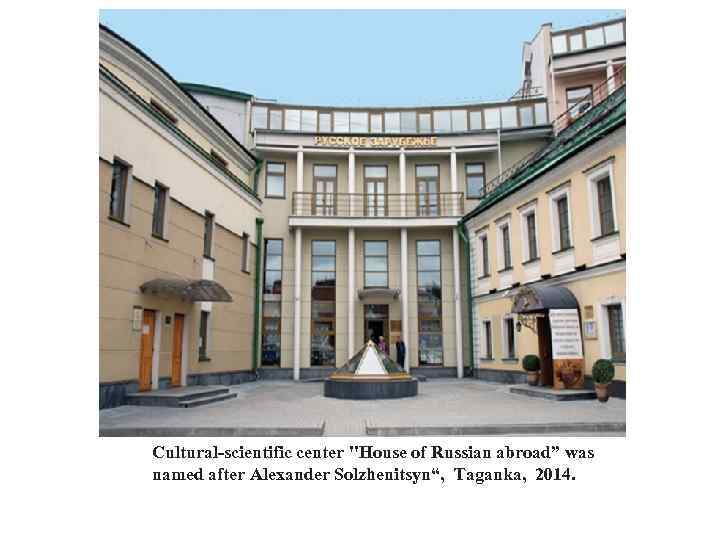
Cultural-scientific center "House of Russian abroad” was named after Alexander Solzhenitsyn“, Taganka, 2014.
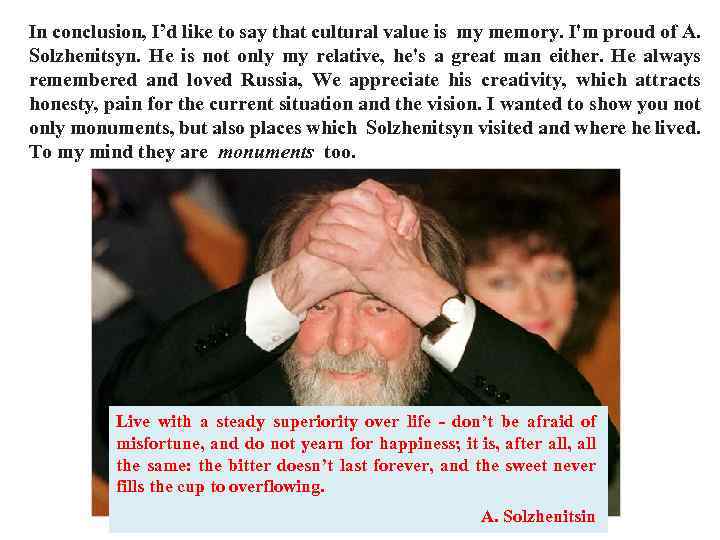
In conclusion, I’d like to say that cultural value is my memory. I'm proud of A. Solzhenitsyn. He is not only my relative, he's a great man either. He always remembered and loved Russia, We appreciate his creativity, which attracts honesty, pain for the current situation and the vision. I wanted to show you not only monuments, but also places which Solzhenitsyn visited and where he lived. To my mind they are monuments too. Live with a steady superiority over life - don’t be afraid of misfortune, and do not yearn for happiness; it is, after all, all the same: the bitter doesn’t last forever, and the sweet never fills the cup to overflowing. A. Solzhenitsin
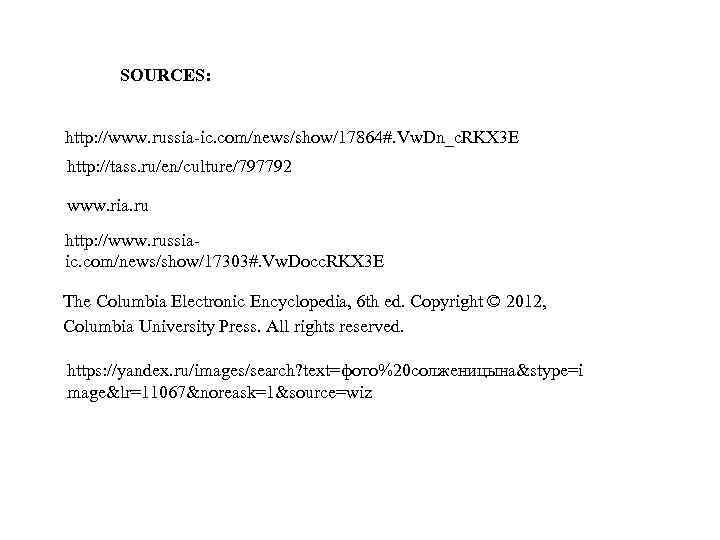
SOURCES: http: //www. russia-ic. com/news/show/17864#. Vw. Dn_c. RKX 3 E http: //tass. ru/en/culture/797792 www. ria. ru http: //www. russiaic. com/news/show/17303#. Vw. Docc. RKX 3 E The Columbia Electronic Encyclopedia, 6 th ed. Copyright © 2012, Columbia University Press. All rights reserved. https: //yandex. ru/images/search? text=фото%20 солженицына&stype=i mage&lr=11067&noreask=1&source=wiz
15 лицей Солженицын.pptx